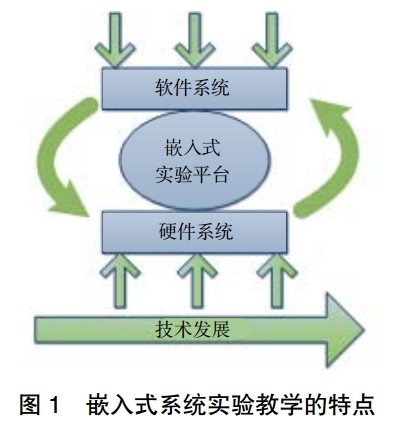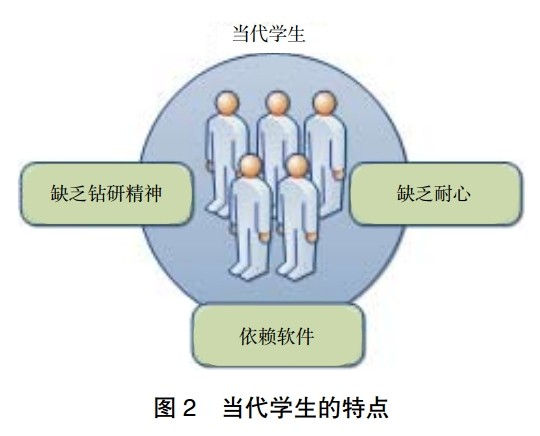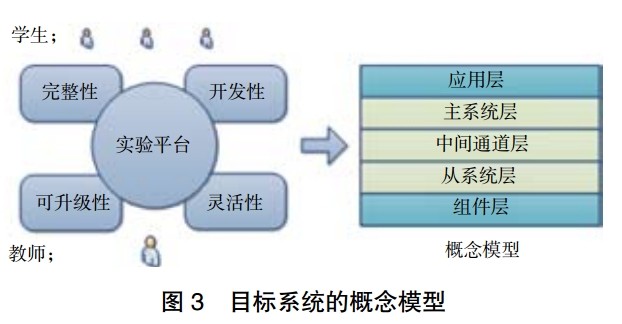Zheng Ninghan, Tao Pin, Song Sichao
(Department of Computer Science and Technology, Tsinghua University, Beijing 100084)
Abstract:The characteristics of embedded systems, which are closely related to practical applications, determine the importance of effective experimental teaching for embedded system courses. This article introduces some explorations in embedded system experimental teaching, analyzes the characteristics of embedded experimental teaching and current undergraduate students, and proposes design principles and conceptual models for embedded experimental platforms.
Keywords:Embedded systems; Experimental teaching; Experimental platform
1 Background
Today, embedded systems play an increasingly important role in daily life. From consumer electronics to aerospace industries, from popular electronic applications (such as smartphones and tablets) to relatively inconspicuous applications (such as satellites), embedded systems directly or indirectly influence all aspects of people’s lives. The enormous potential of embedded systems has kept educators discussing them continuously. Countless educators around the world have proposed many novel and creative methods and theories to promote the improvement of embedded system education, and they mostly agree that embedded systems have significant characteristics closely related to practical applications.
Embedded systems are applied in a wide range of fields, such as simple microcontroller applications, control systems, distributed embedded control, system-on-chip, networks, embedded PCs, critical systems, robotics, computer peripherals, wireless data systems, and signal processing. At the same time, knowledge from some interdisciplinary fields is also important for embedded system designers, such as safety, reliability, energy efficiency, software/system engineering, real-time computing, and human-computer interaction.
For students who aspire to become qualified embedded system designers, it is very important that they can physically interact with these embedded applications, thus designing an efficient experimental system is crucial. The experimental platform should connect abstract theoretical knowledge with practical applications to help students comprehend the mysteries of embedded systems.
2 Characteristics of Embedded System Experimental Teaching
Embedded system experimental teaching differs from other course experimental teaching in two aspects: the high integration of software and hardware, and the rapid pace of knowledge and technology updates. The characteristics of embedded system experimental teaching are illustrated in Figure 1.

The first characteristic of embedded system experimental teaching is the high integration of software and hardware. A complete embedded system needs to operate on the basis of both software and hardware. In embedded experimental teaching, any missing or weakened link is a mistake. We have made this mistake in the past. Embedded systems are a required course for fourth-year undergraduate students at Tsinghua University’s Department of Computer Science and Technology. Students hope to have a complete understanding of embedded systems after the course, but find that after completing this 2-credit course, they still cannot design a complete embedded system that integrates both software and hardware. Therefore, we let students use open-source software tools to design drivers for devices like mice or keyboards, but the results were not ideal because students only became familiar with the parts they experimented with, which were merely a small portion of what they should master. This was due not only to the limitations of the experimental tasks but also because students were unable to engage with hardware-level operations, preventing them from fully grasping embedded systems.
The second characteristic of embedded system experimental teaching is the rapid pace of knowledge and technology updates in embedded systems. As mentioned in Section 1, keeping up with practical applications is a key element of embedded experimental teaching. Due to the ever-evolving technology of embedded systems, the knowledge and skills taught in embedded experimental courses, as well as the experimental devices and components, must continuously develop. In a survey of students in Tsinghua University’s Department of Computer Science and Technology, we found that the main criticism of traditional embedded experimental platforms was that the experimental equipment and components were too outdated, the experimental platform was not closely linked to current technology, and the experimental content lacked attractiveness.
In summary, designing an efficient embedded experimental platform must consider both the integration of software and hardware and the rapid development of embedded technology.
3 Characteristics of Contemporary Students
Besides the embedded experimental course itself, students are another key factor that cannot be ignored. Students are participants in the experiments, and their experiences affect the success or failure of the experimental course teaching. However, we have found that traditional experimental methods have gradually caused contemporary students to lose interest in learning, mainly because students evolve and progress from generation to generation, while traditional experimental methods have remained unchanged for many years.
Literature [2] points out that contemporary students differ from past students: they lack a spirit of inquiry, lack patience, and rely on software. The characteristics of contemporary students are illustrated in Figure 2.

The first characteristic of contemporary students is a lack of inquiry spirit. The vast majority of students grow up in a society where user supremacy is increasingly popular. They focus more on functionality than on basic principles; they focus more on appearances than on architecture. In short, very few contemporary students understand the basic principles of embedded systems. On the other hand, traditional experimental platforms are designed specifically for demonstrating and verifying the principles taught in textbooks, so students gradually fail to link practical applications with specially designed experiments. The problem arises that if students cannot foresee the future applications of the knowledge they learn, they will shift their focus to other areas. Therefore, it is very important to combine experimental platforms with trendy technologies.
The second characteristic of contemporary students is a lack of patience. The increasing pace of life and the growing prevalence of the internet have caused contemporary students to gradually lose patience. They are used to seeing results quickly after starting an experiment, as if they can see a reaction on the screen immediately after clicking the mouse. However, in traditional teaching methods, teaching always begins with a comprehensive description and analysis of the course. Practice has proven that this description is necessary, as it helps students gain a comprehensive understanding of the course’s knowledge structure. However, this content can sometimes deter students because they find the course very abstract and tedious. In light of these issues, the new experimental platform should spark students’ interest from the very first lesson on embedded systems while providing an attractive ‘result’.
The third characteristic of contemporary students is reliance on software. The development of embedded systems is often seen as a result granted by the public. To some extent, this development is a result of electronic engineering evolving towards greater intelligence. However, the invisible aspects of electronic engineering are often disguised by complex user interfaces and other icons, leading people to attribute it to computer science rather than electronic engineering [3]. Many universities do not recognize this issue and focus most of their attention on embedded software design, neglecting the introduction of hardware levels. This erroneous focus in embedded system education leads to the misconception that ‘software is more important than hardware’. To correct this bias, we should value hardware and introduce it into embedded system courses.
In summary, to design an efficient experimental platform, the characteristics of contemporary students must not be ignored.
4 Principles for Designing Embedded Experimental Platforms
Based on the above discussions, we propose several design principles for the embedded system teaching experimental platform.
Completeness: The experimental platform should be relatively complete. Students should not only be able to engage with software but also operate hardware. This principle primarily addresses two issues: first, to correct the students’ erroneous focus on software; second, to attract students from the very first lesson, informing them that they will be able to establish a basic yet relatively complete system by the end of the course.
Development: The experimental platform should help students freely realize innovative ideas. The platform should reserve a sufficient number and types of interfaces for students in both software and hardware, allowing them to build their embedded systems based on this. In practice, more and more application-based embedded systems are realized by students, and their creative enthusiasm is also stimulated.
From a teaching perspective, the experimental platform should include the following characteristics.
Upgradability: The software and hardware of the platform should be extendable and upgradable separately, without needing to modify the entire platform. As mentioned in Section 2, the rapid upgrade of embedded system technology, especially hardware devices, necessitates that the principle of upgradability be placed in a key position.
Flexibility: The experimental content should be adjustable according to the course requirements to facilitate the wide promotion of the experimental platform. Most customized experimental platforms lack flexibility, as their experimental content cannot be increased or decreased, necessitating a redesign of the experiments to accommodate changes in course hours.
To achieve the above goals, we propose a complete conceptual model. The conceptual model of the target system is illustrated in Figure 3.

This conceptual model consists of 3 intermediate layers and 2 outer layers. The intermediate layers include the main system layer, intermediate channel layer, and slave system layer. The outer layers include the application layer and component layer. We will explain how this model can achieve the goals proposed earlier.
Completeness: Viewing the three intermediate layers as a whole, this basic model consists of the main elements found in a typical embedded system, from the top application layer to the bottom functional component layer. Students can access each component of the complete system.
Openness: The top and bottom layers of the model are open to students. The designers of the experimental platform provide a sufficient number of user-friendly software and hardware interfaces to students. Using hardware interfaces, students can construct an innovative embedded device by connecting the necessary hardware modules; using software interfaces, students can conveniently load the software resources required for the hardware modules.
Upgradability: The design of the experimental platform should be modular and hierarchical, with each layer providing upper-level interfaces for the previous layer and lower-level interfaces for the next layer. Each layer can be independently extended and upgraded while maintaining compatibility with the interfaces of adjacent layers. The intermediate layer of the model is designed as a three-layer structure, inspired by the design of Phidgets [4], which can provide more possibilities for the realization of actual devices.
Flexibility: Each layer can be reinforced or weakened according to the course’s focus, allowing the experimental content to vary according to course requirements. Experimental classes can be arranged on two or more layers. Basic experiments require students to establish a basic embedded system, while in advanced experiments, students can delve into the various layers of the model to achieve creative designs.
Based on this conceptual model, it is not difficult for students to design an efficient embedded experimental system.
5 Conclusion
These principles of embedded system design and conceptual models are summarized from our practical teaching experiences, primarily addressing two issues: stimulating students’ enthusiasm for learning embedded systems; and providing students with the freedom to realize creative designs while overcoming the shortcomings of traditional embedded experimental platforms. These principles guide us in designing effective embedded experimental platforms and strengthening the construction of embedded system courses. We hope and are confident that we will play an increasingly important role in helping students gain a deeper understanding of embedded systems.
References:
[1] Koopman P, Choset H, Grandhi R, et al. Undergraduate embedded system education at Carnegie Mellon[J]. ACM Transaction on Embedded Computing Systems, 2005, 4(3): 500-528.
[2] Tsividis Y. Turning students on to the circuits[J]. Circuits and System Magazine, 2009, 9(1): 58-63.
[3] Tsividis Y. Some thoughts on introducing today’s students to electrical engineering[J]. IEEE Circuits and System Society Newsletter, 1998, 9(1): 6-7.
[4] Phidgets. Products for USB Sensing and Control[EB/OL].[2013-12-01]. http://www.phidgets.com.
Author Introduction: Zheng Ninghan, male, engineer, research direction in embedded system experimental teaching, [email protected].
Magazine Email: [email protected]
Website: http://www.jsjjy.com
ISSN: 1672-5913 CN: 11-5006/TP
Postal Publication Code: 80-171
* * * * *
This journal has been included by the following media:
China National Knowledge Infrastructure (CNKI) Full-text included journal
China Journal Full-text Database (GJFD) Full-text included journal
China Academic Journal Comprehensive Evaluation Database (CAJCED) Statistical source journal
China Important Conference Paper Full-text Database (CPCD) Included journal
Wanfang Data – Digital Journal Group Full-text included journal
* * * * *